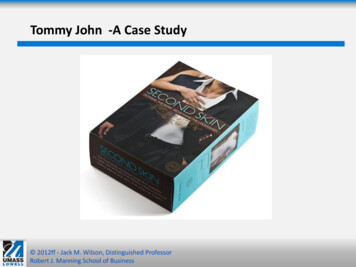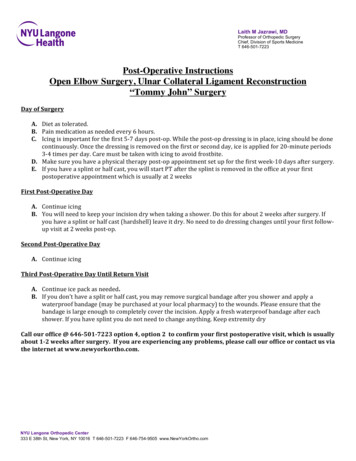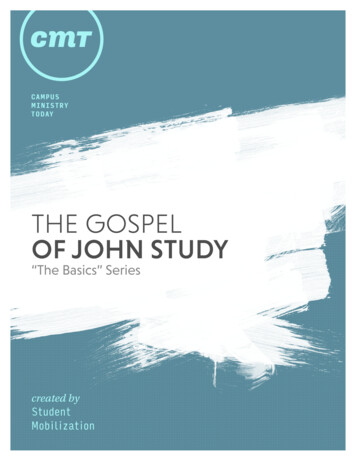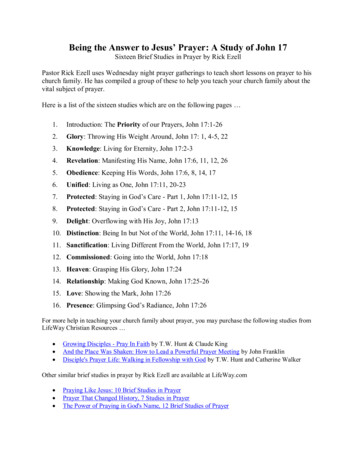
Transcription
Tommy John -A Case Study 2012ff - Jack M. Wilson, Distinguished ProfessorRobert J. Manning School of Business
Tommy John Founder: Tom Patterson, Medical Device Salesman, fan of CNBC’sThe Big Idea with Donny Deutsch– “All of the featured products or services were created out of personalfrustration,” recalls Patterson. “I found myself constantly looking around,asking, ‘What can I make better?’” -Fortune Entrepreneurial Alertness –looking for a big opportunity The Pain: Stepped out of the car and found his undershirt untuckedand bunched up. He would constantly have to tuck his undershirtinto his slacks. It was too baggy, too boxy, too short and didn’t fitwell. Opportunity: No stores offer an undershirt that solved this problem. Solution: He took a sketch to a tailor and had him make aprototype. The prototype was exactly what Tom Patterson wanted. 2012ff - Jack M. Wilson, Distinguished ProfessorRobert J. Manning School of Business
Primary And Secondary Research Tom Patterson asked 15 of his friends and family to try out theundershirts and tell him what they thought.– They loved it and some even wanted to order more. He bought 200 more undershirts He found an attorney to patent it. Online research shows that the men’s undergarments marketis a 30 billion industry worldwide. 2012ff - Jack M. Wilson, Distinguished ProfessorRobert J. Manning School of Business
Primary Research by Watching Customers Tom Patterson spent many hours at department storeswatching people buy the men’s undershirts. He drew twomajor conclusions:1.2.People either bought quickly or they didn’t know which alternativesto buy. Those who bought quickly went for the brand they’ve beenbuying for years.Men only buy undershirts for 17 years in their lifetime. From birthto 17, their mothers will buy their undershirts. From age 34 on,their wives by for them. Thus he concluded that women are themajority of the buyers –not men! 2012ff - Jack M. Wilson, Distinguished ProfessorRobert J. Manning School of Business
Tommy John (cont.) Niche: Affordable undershirts that has a perfect combinationof fit, comfort, breathability, and style. Market: Women buying their kids, boyfriends, husbandsundershirts. Mission :– “Renowned for its innovative fit, feel, and functionality, Tommy John isthe solution for the modern man who desires luxurious clothing at anaffordable price.”– “Tommy John took what was once a basic undershirt and hasredesigned it to be an indispensable part of every man’s wardrobe. Wehave quickly become the go to brand for men everywhere.” 2012ff - Jack M. Wilson, Distinguished ProfessorRobert J. Manning School of Business
Tommy John – Finding the Fabric In 2008, Tom Patterson continued to work on his undershirtprototypes. He decided on the name “Tommy John”. He tested many fabric blends trying to develop the perfectcombination of fit, function, comfort, breathability, and style. A fabric named “micro modal” (came from beech trees). 2012ff - Jack M. Wilson, Distinguished ProfessorRobert J. Manning School of Business
Packaging for Success He felt that a good package design was important to the firm’ssuccess. Hi packaging used feminine colors: chocolate brown andTiffany blue.– (This idea came from his intuition that “women had high positives forboth chocolate and Tiffany jewelry). 2012ff - Jack M. Wilson, Distinguished ProfessorRobert J. Manning School of Business
Finding a way to go to market Tom Patterson called his undershirts, “The Second SkinCollection”, because it fits well like a “second skin”. He first tried to sell to men’s specialty stores with littlesuccess. He later decided to try to get distribution in departmentstores instead. He got through to a Newman Marcus buyer and spoke to herabout his ideas over the phone. They were to meet thefollowing week. 2012ff - Jack M. Wilson, Distinguished ProfessorRobert J. Manning School of Business
Neiman Marcus is sold on Tommy John Before he hung up, he asked the buyer if she’d mind if he sendsamples to her husband and some men in the office. Sheagreed. When they met, the buyer said that the men who got the shirtwere really impressed. She decided to test it out in 15 Newman Marcus stores. Within the first month, the undershirts achieved a 60 percentsell-through rate. They later expanded to 42 stores Within three months Nordstrom also became a customer. Soon they were nationwide 2012ff - Jack M. Wilson, Distinguished ProfessorRobert J. Manning School of Business
“I found the most perfect undershirt. It is made by a companycalled Tommy John. It has changed my life.”– Andrew Sorkin –NY Times (quoted on the Tommy John website) “It is the most brilliant underwear on the planet, and I’m notkidding. Tommy John has saved and changed my life.” –– Howard Stern (quoted on the Tommy John website) 2012ff - Jack M. Wilson, Distinguished ProfessorRobert J. Manning School of Business
Revenue Growth Revenue in 2011 was 1.5 million, up from 900,000 in 2010 2012ff - Jack M. Wilson, Distinguished ProfessorRobert J. Manning School of Business
Discussion Questions Break into small groups of 4-5 people and discuss and come to a common answerto these which you can later share with the class: 1. Write a concept statement for Tommy John. If Tommy John was still in the startup stage and Tom Patterson asked you to whom he should distribute the conceptstatement, what would you have told him? 2. What type of gumshoe research did Tom Patterson benefit from when he wasdeveloping Tommy John, and what additional gumshoe research could he haveconducted while he was investigating the feasibility of his business? 3. If you were running Tommy John, would you try to move into the market forwomen’s underwear? Elect a team spokesperson to present your statement and answers to the class. 2012ff - Jack M. Wilson, Distinguished ProfessorRobert J. Manning School of Business
Discussion Questions Make a list of people whom Tom Patterson talked to about hisproduct during the design phase.– What insight(s) does this list provide you about the nature of feasibilityanalysis process? Were there any tactics that Tom Patterson used to getfeedback about his product that you think were particularly clever? What types of insights did Tom Patterson pick up by spending hoursin stores watching people buy men’s undershirts? What role didthese insights play in the final design of the product? In what waysdo you think Tommy John products might be different today if TomPatterson hadn’t spent the time watching people buy men’sundershirts that he did? Complete a First Screen analysis for Tommy John. What did youlearn from the analysis?– four areas of product/service feasibility, industry/target market feasibility,organizational feasibility, and financial feasibility. 2012ff - Jack M. Wilson, Distinguished ProfessorRobert J. Manning School of Business
Tommy John references YouTube http://www.youtube.com/watch?v jqtbsM6b7ZU Tommy John: http://www.tommyjohnwear.com/?gclid CMOGn4Xg6MACFWwQ7Aod0VoAtQ Men's underwear leaves the Stone -leaves-the-stone-age/ Tommy John Underwear: Tames Sweat, Stays Tucked, Changes my-new-underpants-just-changed-my-life.html 2012ff - Jack M. Wilson, Distinguished ProfessorRobert J. Manning School of Business
called Tommy John. It has changed my life." -Andrew Sorkin -NY Times (quoted on the Tommy John website) "It is the most brilliant underwear on the planet, and I'm not kidding. Tommy John has saved and changed my life." - -Howard Stern (quoted on the Tommy John website)










